Article and all photos by Joe Mock, BaseballParks.com
All rights reserved
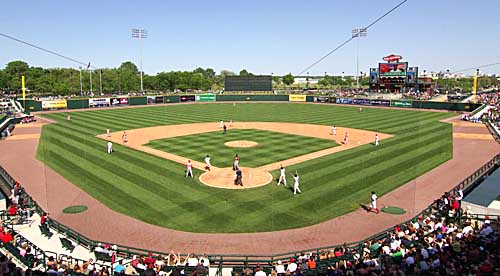 |
About a month before I made my visit to Dow Diamond, the new Midwest League ballpark in Midland, Michigan, I stopped by the headquarters of HOK Sport in Kansas City. As architects of some of the most noteworthy sports facilities on the planet, they have the right to be proud of a number of projects they’d designed. It struck me, though, that they seemed particularly proud of the ballpark they’d designed in Midland. I wondered why.
| Ballpark Stats |
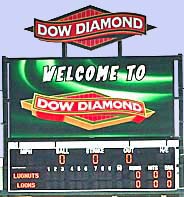 |
| Team: The Great Lakes Loons of the Class A Midwest League |
| First game: April 13, 2007, a 6-2 loss to Lansing |
| Capacity: 5,500 (3,880 seats in seating bowl, suites and pavilion, rest are on berms) |
| Architects: HOK Sport |
| Price: $34 million (construction only. The land was donated by Dow Chemical) |
| Home dugout: First base side |
| Field points: Northeast |
| Playing surface: mixture of Kentucky bluegrasses |
| Betcha didn’t know: the warning tracks are made of crushed bricks from the Dow Chemical building that once stood on this site. |
Once I stepped into Midland’s ballpark, I knew why. The place is phenomenal, especially when you consider that the franchise it houses plays in a Single-A league.
As I toured Dow Diamond (the team prefers that you not call it the Dow Diamond — just “Dow Diamond”) and learned more of its brief history, I started to see why it is such a significant structure. It didn’t suffer from the malady that befalls so many minor league ballparks. Normally, when a city or county intends to construct a sports facility, it first selects an architect to create a design that everyone is thrilled with. Construction commences as the team and the city tell the fans “it will be the finest Minor League ballpark in the country!”
However, the cost of steel, concrete and manpower start to come in over budget, and some last-minute revisions to the original design are made in order to cut costs. The luxury suites are scaled back, the size of the press box is reduced and they decide to make the seating capacity a little smaller. This process is often referred to as “value engineering.”
Occasionally, though, value engineering isn’t as necessary. That’s usually when an entity other than a local government is writing the checks. In those cases, depending on how deep the pockets are of the benefactor, the last-minute design cutbacks are greatly reduced. In this regard, the very, very substantial minor-league ballparks in Memphis and Springfield, MO come to mind.
And with Dow Chemical behind much of the funding of the ballpark project in Midland, Michigan, there wasn’t the need to slash the budget by eliminating the niceties in the park’s design. The result is a stupendous facility, one that has features that are well beyond the level of the league that plays there. Consequently, Dow Diamond is reminiscent of Springfield’s Double-A ballpark that is virtually Triple-A in scope, and AutoZone Park in Memphis, which is the closest thing to the Majors in all of Minor League sports. Amazingly, though, this significant park in Midland doesn’t sacrifice its sense of intimacy, as we shall see.
So Dow Diamond is an impressive ballpark … but what makes it so? Let’s look at the park’s location, exterior, interior design and the amenities for the fans:
The Setting
There’s not a city skyline or mountains to look at when you’re in the seats at Dow Diamond. What you do notice, though, are the chemical plants that are behind and beyond the first-base line southeast of the ballpark. That’s because the stadium was constructed on land donated by Dow Chemical. As a consequence, a massive amount of the land adjacent to the park holds chemical plants.
These plants are not an eyesore by any means. Rather, their twinkling lights are fun to watch at night, in much the same way as the chemical plants around the independent-league ballpark in Robstown, TX put on a light show for the fans at that park. In the background of the shot below, you can see these plants beyond the park’s playground.
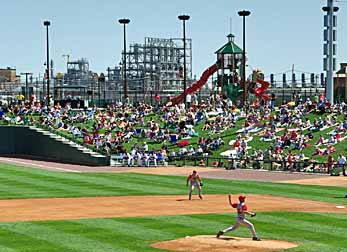 |
Another interesting aspect of the site is that a segment of the 30-mile Pere Marquette Rail-Trail crosses it, and the team designing the park felt that the trail shouldn’t be interrupted by the stadium. “Working closely with local foundations, we developed a design concept that allows the park-like trail to wrap the perimeter of the ballpark site,” said Martin DiNitto, the senior project manager for HOK Sport. The landscaping along the trail, by the way, is beautiful.
Although you can’t see it from within the park, the Tittabawassee River is less than 200 feet from the southwestern edge of the park’s property. This actually impacted the overall design of the stadium. Because the water table is so near the surface on this spot, the field needed to be at ground level — as opposed to being dug into the ground like at most new parks. This means that fans must walk up stairs to get to the main concourse that is at the rear of the seating bowl, much like at other water-side parks in Trenton, NJ and Corpus Christi, TX.
The Exterior
When you attend a game at Dow Diamond, make a point of taking a look at the exterior of the eastern end of the stadium — even if you park and enter the stadium from beyond the right-field gate on the west end. That’s because its use of glass and color is stunning. The sloping green roof also gives the structure a classic-ballpark feel. The Loons “wanted the ballpark to convey a traditional ballpark ambiance,” DiNitto added. “The design blends tradition with innovation.”
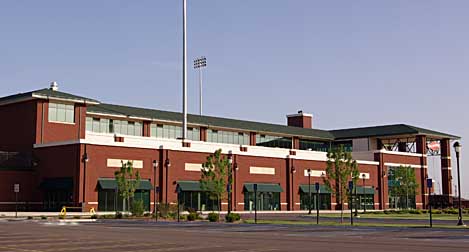 |
In particular, the entryway behind homeplate is spectacular (lower left). It takes full advantage of the fact that the concourse is one story up from ground level, as the tall, covered entrance surrounds the wide stairway. The masonry is wonderful, as the contrasting colors really add visual appeal. Touches like this really set a facility like this apart from ones without such attention to detail. There is also a nice entryway in right field, but you’ll marvel at the one behind home.
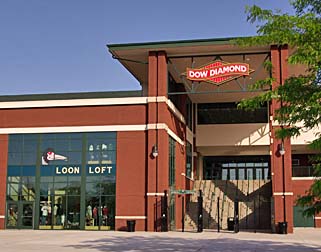 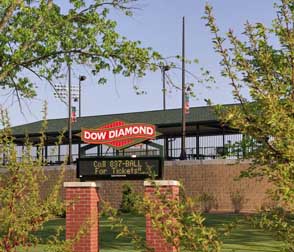 |
In fact, there are many impressive touches incorporated into Dow Diamond’s exterior, especially along the northern side of the property. This is the side along the well-traveled thoroughfare, U.S. Route 10 Business. Here you’ll find lovely landscaping reminiscent of a city park (above right).
The Design
When I enter a new ballpark that was designed by an architectural firm that lacks experience in designing sports facilities, I sometimes (not always, though) get an uneasy feeling. Often the path fans have to take to get to their section isn’t direct, or you can’t see the field from the concourse. However, when HOK — the most prominent designers of sports facilities in existence — is your architect, you don’t have to worry about things like that.
Indeed, HOK not only designed a stadium that works well from a baseball perspective (bullpens, dugouts, grounds-crew access to the field, etc.), their plans resulted in a wonderful playpen for the fans. The design achieves the difficult double-barrel objective of creating an intimate setting while making things comfortable for the spectators.
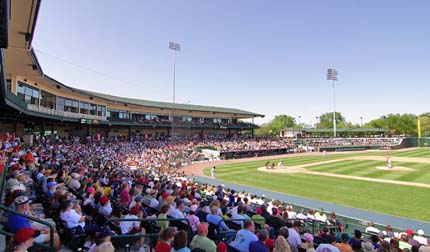 |
First, let’s look at the intimacy element. The seating capacity — fewer than 4,000 fixed seats — is absolutely perfect for the level of play and the size of their market. No matter how well the team does in the attendance department, there is little chance of a move to a higher league. The Loons are in the Midwest League, which is known as “low A,” the middle of the three Class A levels (high A, low A, short-season A). Geographically, there isn’t a high-A or double-A league anywhere close by, so the Loons are likely to remain at the low-A level for the foreseeable future. Therefore, it made sense to design the park to be appropriate for the Midwest League, and no more.
And that’s exactly what was done by HOK and the Michigan Baseball Foundation, the non-profit corporation that owns the Loons franchise and the stadium (but that is transferring control of the team to a different entity, one that is taxable, with similar leadership). In other words, they resisted the temptation to “over-build.” As far as the seating bowl goes, it is the perfect size, and keeps the atmosphere very intimate.
You really appreciate this when you compare Dow Diamond to Michigan’s two other Midwest League ballparks, Lansing’s Oldsmobile Park and West Michigan’s Fifth Third Ballpark. These two facilities are both quite nice, but “intimate” isn’t an adjective you would apply to them. In fact, both of those ballparks can hold twice as many fans as Dow Diamond.
From a comfort perspective, the rows in the seating bowl are 36″ apart, providing more leg room than at most other parks. Not quite at the mega-spacious 42″ at Lubrano Park in State College, PA, but close. No seat in the park is less than 20″ wide, giving most fans a comfortable fit.
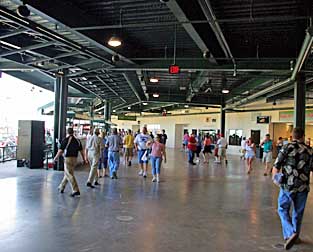 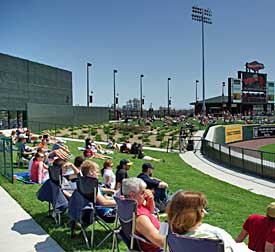 |
The other way in which the comfort of the fans comes into play involves the concourses. Not only can you easily see the field while strolling to a concession stand (that is, it is a so-called “open concourse”), those concourses are extremely wide. No bottle necks getting out of this park once the game is over!
Further, it has one of my favorite ballpark features, one I refer to as a “360-degree concourse,” just like 2007’s other new park, Dickey-Stephens Park in North Little Rock, AR. And like at the Travelers’ new facility, I urge you to take a walk all the way around the field. You’ll see some features that we’ll address in the next section of this review.
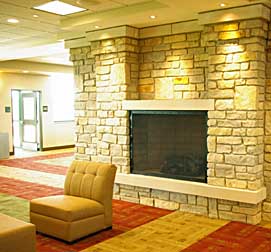 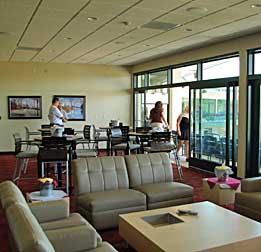 |
Behind the seating bowl is the structure that essentially contains three stories. The ground floor has the clubhouses, team offices and the lower level of the souvenir shop. The middle level has the concourse with all of its concession stands and restrooms. The upper floor, meanwhile, has the suites and press box. From a “proportion” standpoint, this structure — particularly the eastern part behind third base — is almost too large considering the small seating capacity of the ballpark. You’ll especially notice this when looking at the exterior of Dow Diamond, as beautiful as that exterior is.
The reason the structure is so substantial is because of the incredible upper level. I’ve visited virtually every Minor League ballpark in the country, especially at the high-A, double-A and triple-A levels, and only Memphis (which is the most “Major League” of any Minor League sports facility ever built) has a better, bigger suite level than Dow Diamond. It is fully enclosed, so the air conditioning and heating keep it perfectly comfortable at all times. There’s even a fireplace for those chilly April games (above left). The halls to the 12 suites, and the suites themselves (above right), are fabulous. And the press box (below center) is the nicest I’ve ever seen in the Minors.
Similarly, the souvenir shop (below left) is one of the nicest below the big leagues. At the Class A level, only Brooklyn’s might come close. The fact that the Loon Loft is on two floors gives the talented Ann Craig, the Director of Retail Operations who brings experience with Disney to the team store, sufficient space to display the cute Loons merchandise.
 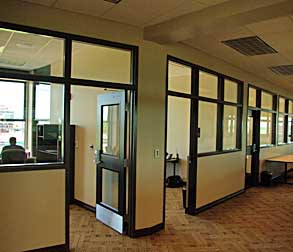  |
One aspect of the design, though, really puzzled me. I noticed at each end of the covered concourse were large, sliding doors (above right). Greg Kigar, the Loons’ Director of Stadium Operations, explained to me that not only could the ends of the concourse be sealed, so could all of the open areas that face the field. “That way, we can provide 15,000 square feet of enclosed meeting space for a trade show or other event,” he explained. “And we can do it at any time of year because it can be heated or cooled.”
In that respect, Dow Diamond provides the city of Midland with badly needed meeting space in much the same way as the United Heritage Center at the Dell Diamond has done for Round Rock, TX.
Finally, the field of play deserves mention. As is the case at a number of new parks, there are pipes under the field to draw rain water away, making the field playable in short order after a downpour. Head Groundskeeper Matt McQuaid said, “It’s like a mini Comerica Park in that (the underground pipes) draw away upwards of three inches of rain an hour.” He added that when he came onboard, Dow Diamond’s field hadn’t been started yet. That let him oversee everything about its installation.
So not only does the Kentucky bluegrass turf look fantastic, a storm won’t necessitate the postponement of that evening’s game.